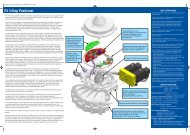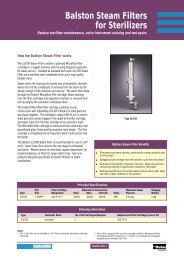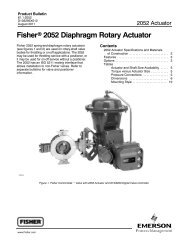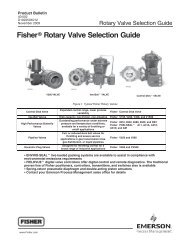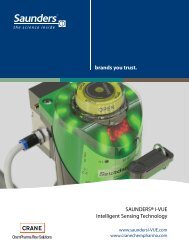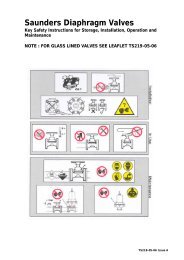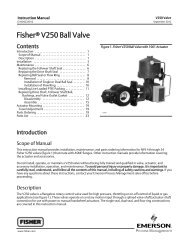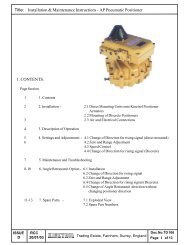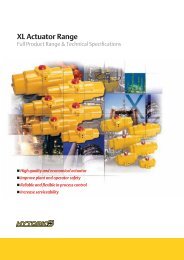Fisher® FIELDVUE DVC6200 Digital Valve Controller
Fisher® FIELDVUE DVC6200 Digital Valve Controller
Fisher® FIELDVUE DVC6200 Digital Valve Controller
You also want an ePaper? Increase the reach of your titles
YUMPU automatically turns print PDFs into web optimized ePapers that Google loves.
Maintenance and Troubleshooting<br />
July 2012<br />
Instruction Manual<br />
D103605X012<br />
To check the Voltage Available at the instrument, perform the following:<br />
1. Connect the equipment in figure 2‐3 to the field wiring in place of the <strong>FIELDVUE</strong> instrument.<br />
2. Set the control system to provide maximum output current.<br />
3. Set the resistance of the 1 kilohm potentiometer shown in figure 2‐3 to zero.<br />
4. Record the current shown on the milliammeter.<br />
5. Adjust the resistance of the 1 kilohm potentiometer until the voltage read on the voltmeter is 10.0 volts.<br />
6. Record the current shown on the milliammeter.<br />
7. If the current recorded in step 6 is the same as that recorded in step 4 (± 0.08 mA), the voltage available is<br />
adequate.<br />
8. If the voltage available is inadequate, refer to Wiring Practices in the Installation section.<br />
Restart Processor<br />
This is a “soft” reset of the device. This procedure can only be performed while the instrument is out of service. A soft<br />
reset will immediately put into effect changes that have been sent to the instrument. Also, if the device is configured<br />
to shutdown on an alert, the soft reset will clear the shutdown.<br />
Table 6‐3. Instrument Troubleshooting<br />
Symptom Possible Cause Action<br />
1. Analog input reading at<br />
instrument does not match<br />
actual current provided.<br />
2. Instrument will not<br />
communicate.<br />
1a. Control mode not Analog. 1a. Check the control mode using the Field Communicator. If in<br />
the <strong>Digital</strong> or Test mode, the instrument receives its set point as<br />
a digital signal. Control is not based on input current. Change<br />
Control Mode to Analog.<br />
1b. Low control system compliance voltage. 1b. Check system compliance voltage (see Wiring Practices in<br />
the Installation section.<br />
1c. Instrument shutdown due to self test failure. 1c. Check instrument status using the Field Communicator (see<br />
Viewing Instrument Status in the Viewing Device Information<br />
section).<br />
1d. Analog input sensor not calibrated. 1d. Calibrate the analog input sensor (see Analog Input<br />
Calibration in the Calibration section).<br />
1e. Current leakage. 1e. Excessive moisture in the terminal box can cause current<br />
leakage. Typically the current will vary randomly if this is the<br />
case. Allow the inside of the terminal box to dry, then retest.<br />
2a. Insufficient Voltage Available. 2a. Calculate Voltage Available (see Wiring Practices in the<br />
Installation section). Voltage Available should be greater than or<br />
equal to 10 VDC.<br />
2b. <strong>Controller</strong> output Impedance too low. 2b. Install a HART filter after reviewing Control System<br />
Compliance Voltage requirements (see Wiring Practices in the<br />
Installation section).<br />
2c. Cable capacitance too high. 2c. Review maximum cable capacitance limits (see Wiring<br />
Practices in the Installation section).<br />
2d. HART filter improperly adjusted. 2d. Check filter adjustment (see the appropriate HART filter<br />
instruction manual).<br />
2e. Improper field wiring. 2e. Check polarity of wiring and integrity of connections. Make<br />
sure cable shield is grounded only at the control system.<br />
2f. <strong>Controller</strong> output providing less than 4 mA to loop. 2f. Check control system minimum output setting, which should<br />
not be less than 3.8 mA.<br />
2g. Disconnected loop wiring cable at PWB. 2g. Verify connectors are plugged in correctly.<br />
2h. PWB DIP switch not set properly. 2h. Check for incorrect setting or broken DIP switch on the back<br />
of the PWB. Reset switch or replace PWB, if switch is broken. See<br />
table 6‐2 for switch setting information<br />
66




